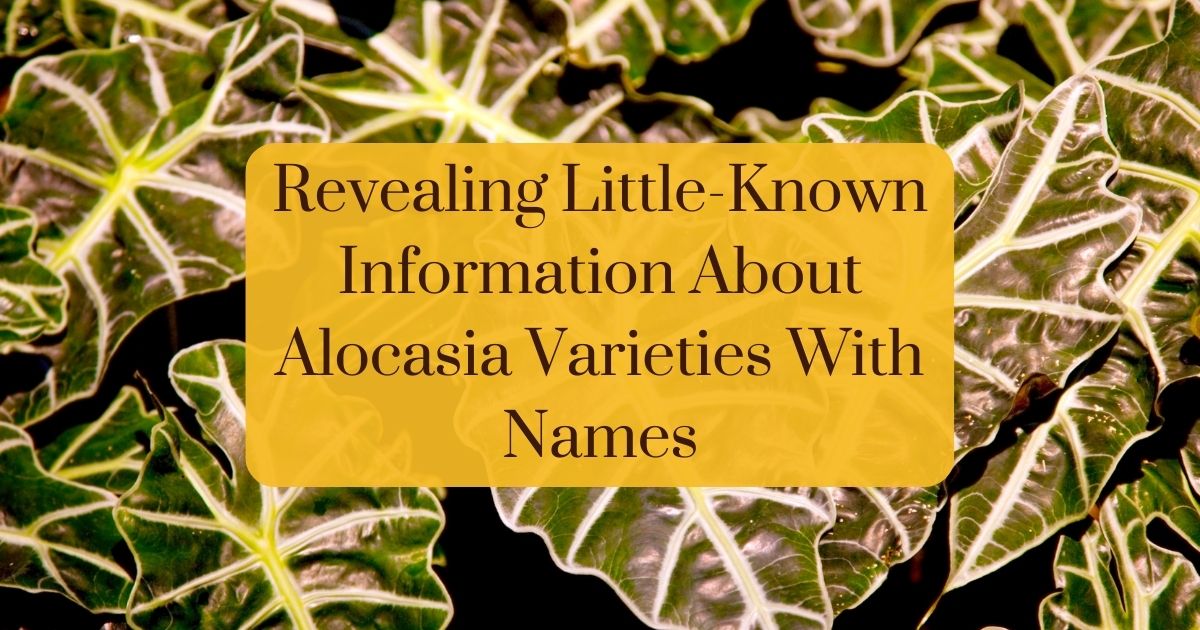The Alocasia House Plant
There are Alocasia varieties with names that you can grow in your home. They are not the easiest indoor plants to maintain (compared to, for example, Chinese evergreens, wandering jew, or spider plants), but if you love the feel of a tropical jungle in your house, they are worth the effort.
To assist you in finding the ideal plant for your house, Alocasia varieties with names and pictures are below.
25 Alocasia Varieties With Names
Alocasias are among the most eye-catching indoor plants due to their amazing foliage and aesthetic appeal. Some Alocasia types, native to subtropical Asia and eastern Australia, boast astonishing three-foot-long leaves. These plants will stand out in your collection of houseplants.
Due to their genetic relationship, plants in the Alocasia genus share many basic properties, although the various Alocasia varieties exhibit significant variations in size, color, leaf size, and form.
Alocasia variations from more than 80 species are difficult to find. Nevertheless, we try to choose the ones with the most beautiful foliage in terms of texture, shape, color, and size for you. Therefore, any of them could be an excellent addition to your collection of houseplants.
Just a reminder: they need your care because they’re meticulous and don’t develop well without proper care. The following is a description of these variations’ peculiarities and distinctive qualities.
Alocasia Amazonica ‘Polly’
The Alocasia Amazonica’ Polly‘ is the first and most prevalent species. This is undoubtedly a part of your collection of indoor plants because it is so beautiful. Additionally, it has eye-catching dark green foliage that enhances the beauty of the silver-white veins.
It will add a touch of the tropics to your indoor space. It is not as desperate. It grows quickly with the proper care. You’ll be happy with a lovely bloom occasionally. It is also a hybrid plant consisting of longiloba and sanderina, though. Its beauty ensures that it will always be a graceful houseplant.
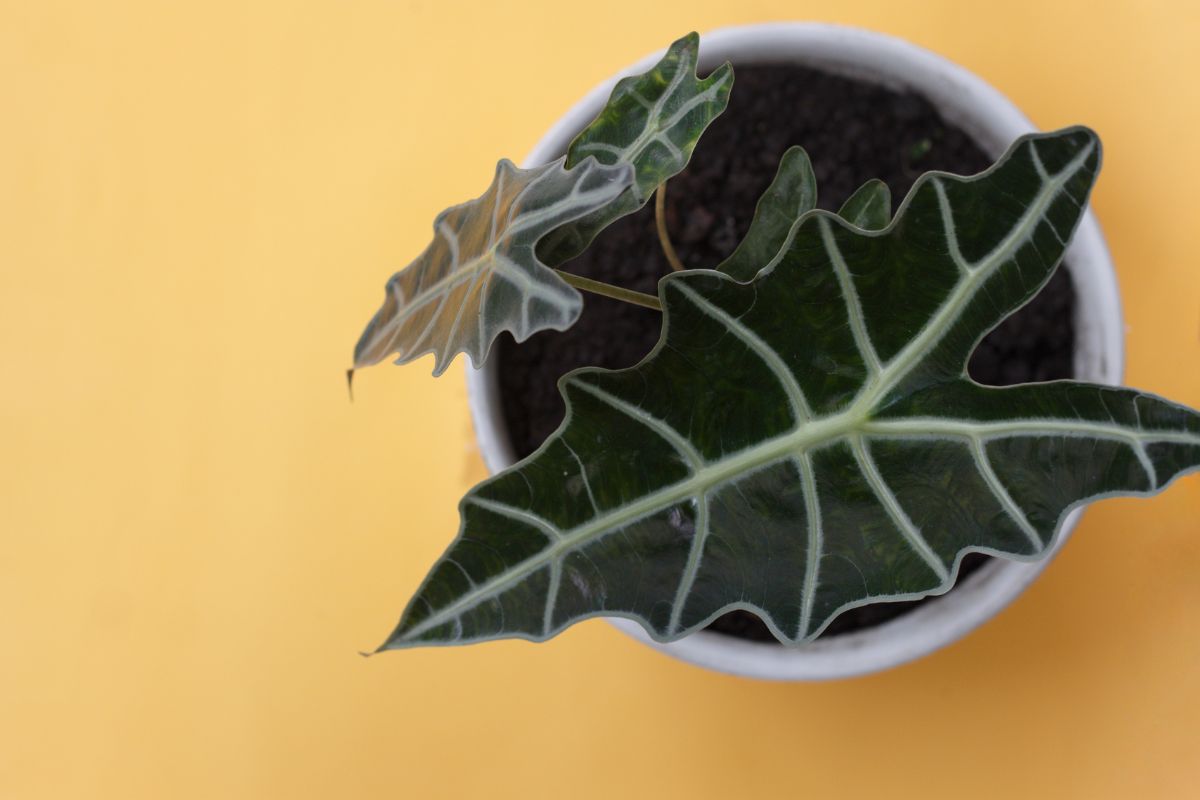
Alocasis Brinsiflora
At the moment, this plant is scarce. Like philodendron plants, these plants have vivid green foliage. The stems have zebra-like speckling and a delicate pink tint. They are famous for their lovely leaves and smooth, herbaceous vegetation.
Every plant enthusiast wants this in their collection because it requires little upkeep. Additionally, it looks attractive.
Alocasia Silver Dragon
The Alocasia Silver Dragon is the most alluring. It will appeal to all plant lovers because it has magnificent silver-green, heart-shaped leaves. Its magnificent vein has a deep green color. You can find one foliage on a single stalk. It is a low-maintenance plant, so you must take care of it despite your hectic schedule.
This plant cleans up the area around it. It bestows its gorgeous appearance on you with indirect bright light. It is flourishing both inside and outside. It will be a terrific choice for your addition if you add them to your houseplant.
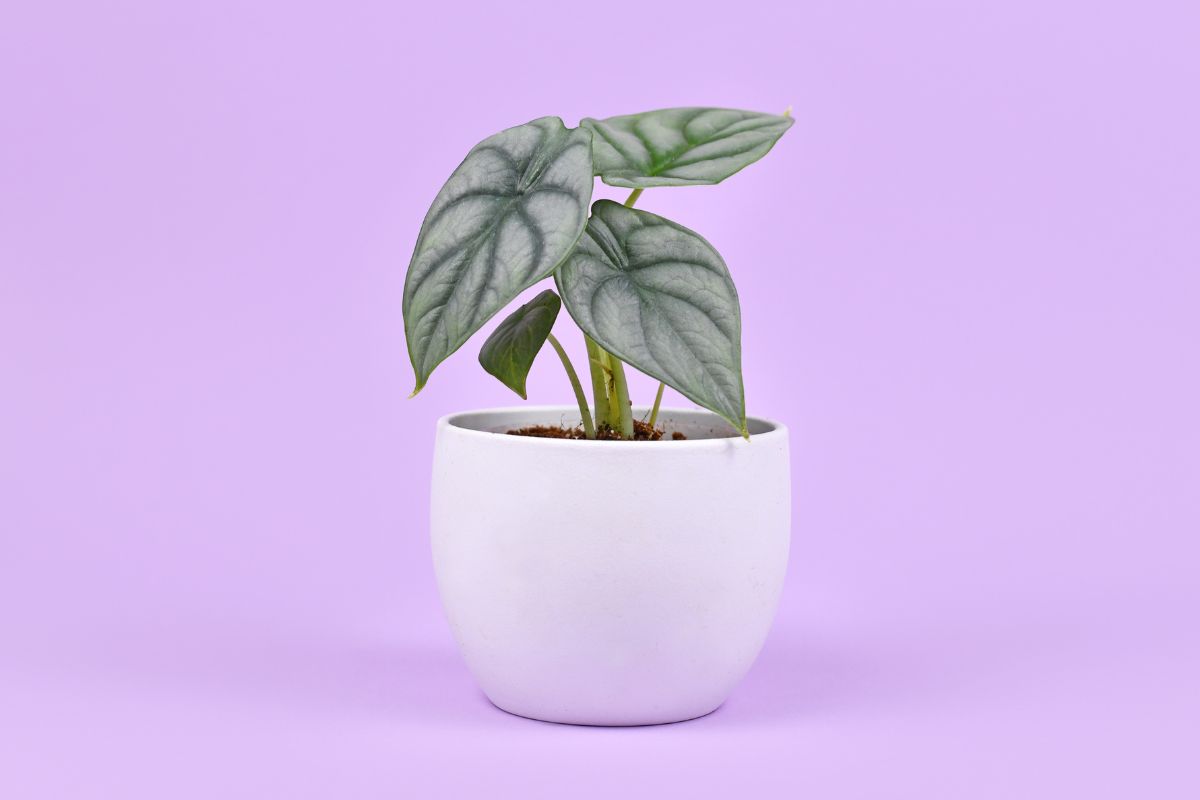
Alocasia Nebula
The most expensive Alocasia variety in the world is Alocasia Nebula. If you see their leaves, you must follow them. The two-line patterning on the leaves, one heavy and one delicate and beautiful, is silvery gray or deep blue.
This kind of Alocasia is relatively uncommon. The Alocasia Nebula requires a lot of upkeep. For new growth, a high-humidity environment is necessary. Refrain from soaking them in water during winter.
Anastacia Portei
This species, which possesses the most striking leaves in the Alocasia family, is large-growing. The leaves create a tropical vibe. This plant is an exceptional addition to the yard thanks to its immense height and broad segment, heavily lobed leaves. Smooth and evergreen foliage is present. It has a pleasing purple hue on the stems.
Every plant enthusiast wants this in their collection because it requires little upkeep. It is exceptional. Growing this plant in containers is simple. Anyone can manage it with ease.
Alocasia Reversa
The veins on Alocasia Reversa are dark in hue. It stands out on its own. Reversa gets its name from the color pattern of its leaves, which is the opposite of that of other Alocasia leaves.
Every plant enthusiast wants this in their collection because it requires little upkeep. Additionally, it looks attractive. Anyone can manage it with ease.
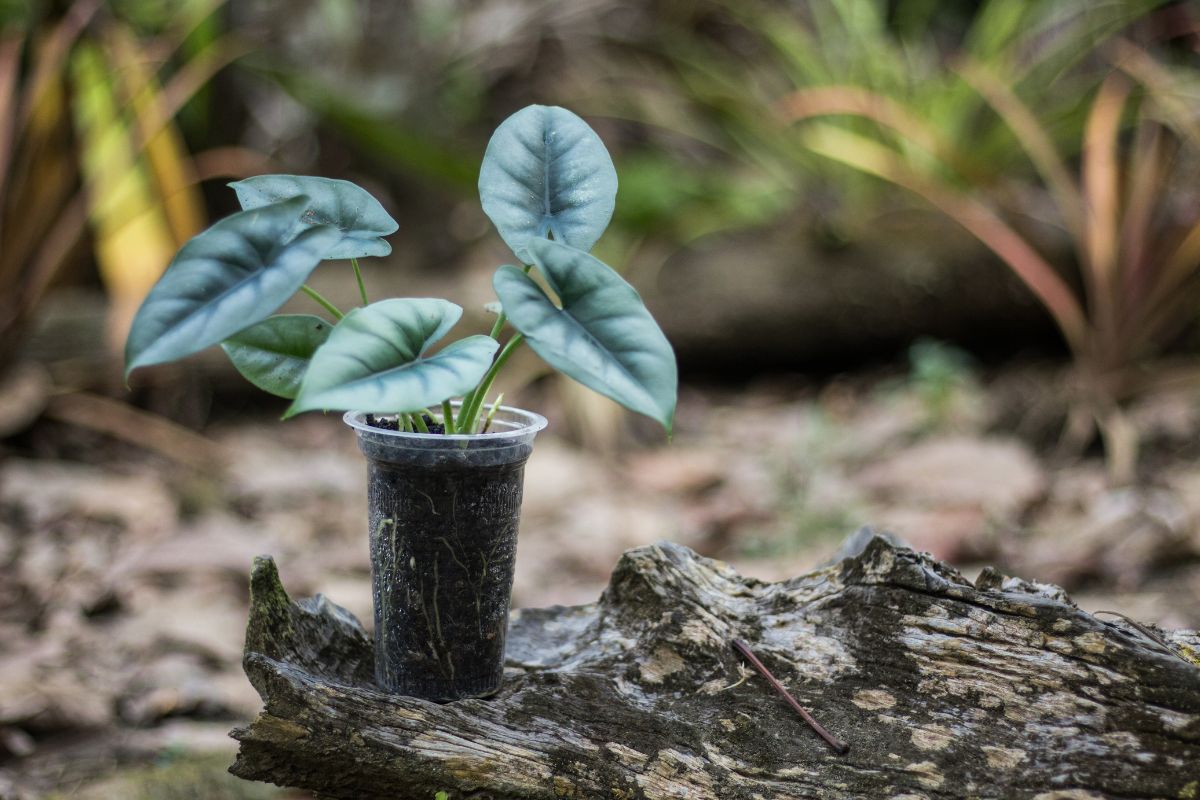
Anastacia Melo
This is a rare Alocasia species. This plant’s thickest and most highly textured leaves make it another eye-catching gem. The leaves have an erect terrestrial petiole and range in hue from jade green to greenish blue.
Every plant enthusiast wants this in their collection because it requires little upkeep. Additionally, it looks attractive.
Alocasia Wentii
Because of its leaves, Alocasia wentii is also popular as the huge elephant ear. This dark Alocasia is a leaf with a dark green arrow form. The underside of the leaf has a different shade of crimson. It flourishes well with enough water. Any plant enthusiast will notice its leaves and wish to incorporate them into their landscape.
This plant will move quickly with the right treatment. It can grow both inside and outside. It will offer your yard a tropical feel. You can include it in your space to create a glam indoor plant.
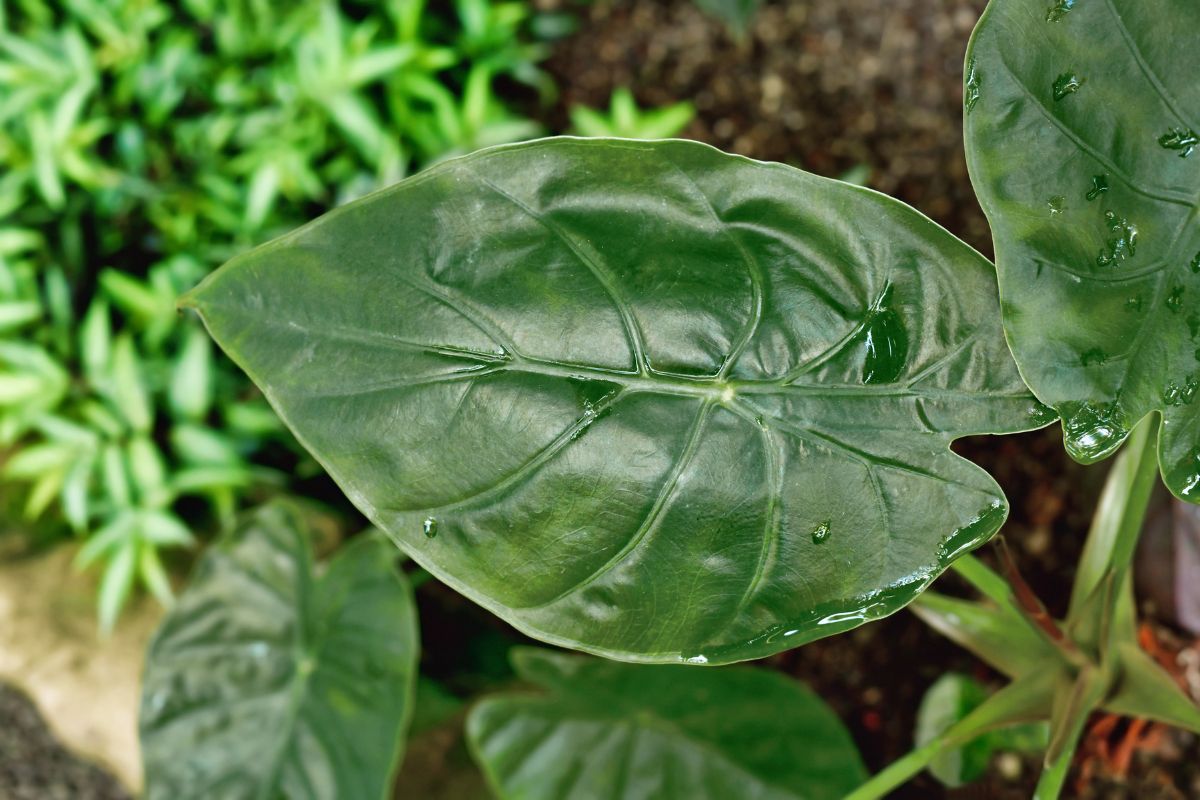
Alocasia Zebrina
Alocasia zebrina stem gives it a distinctive look. The stem has a print in black and yellow. It resembles a tiger stripe. The leaf’s structure is arrow-like, and its leaves are exquisitely green.
Even though leaves come in a wide variety, Alocasia plants are large, although the Zebrina is a little picky. It will grow accurately if given the proper care. It produces white blooms in the spring. If you include them, it will cast a light spot on your home and room.
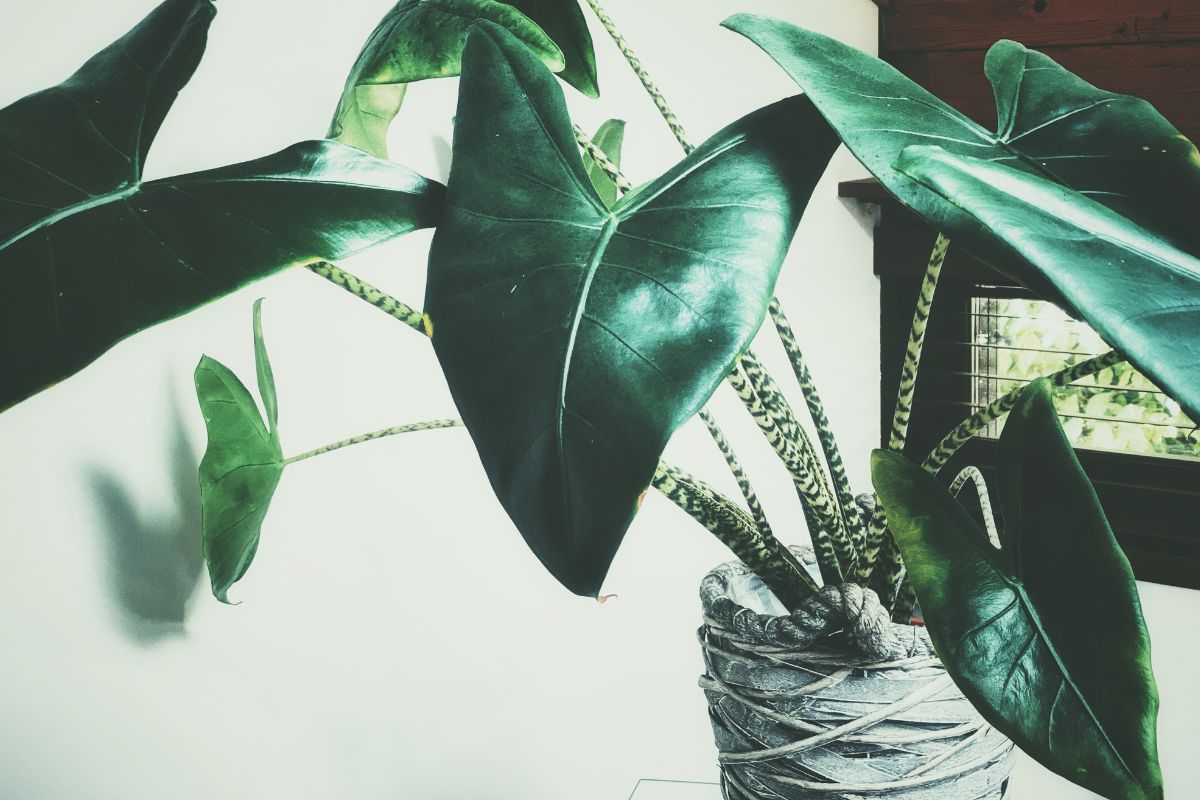
Black Velvet Alocasia Reginula
Alocasia Black Velvet has stunning leaves and is a lovely plant. It is unusual due to the silver spot’s underside. It has a short stem that extends from the leaves and a silver branch.
It is a low-maintenance plant that multiplies. It produces a white spadix finger that blooms like a flower within a year. Alocasia reginula has a sluggish appearance in the winter. It provides a strong contrast in a green terrarium environment. It is a rare dark gem. You’ll be happy to include it in your addition.
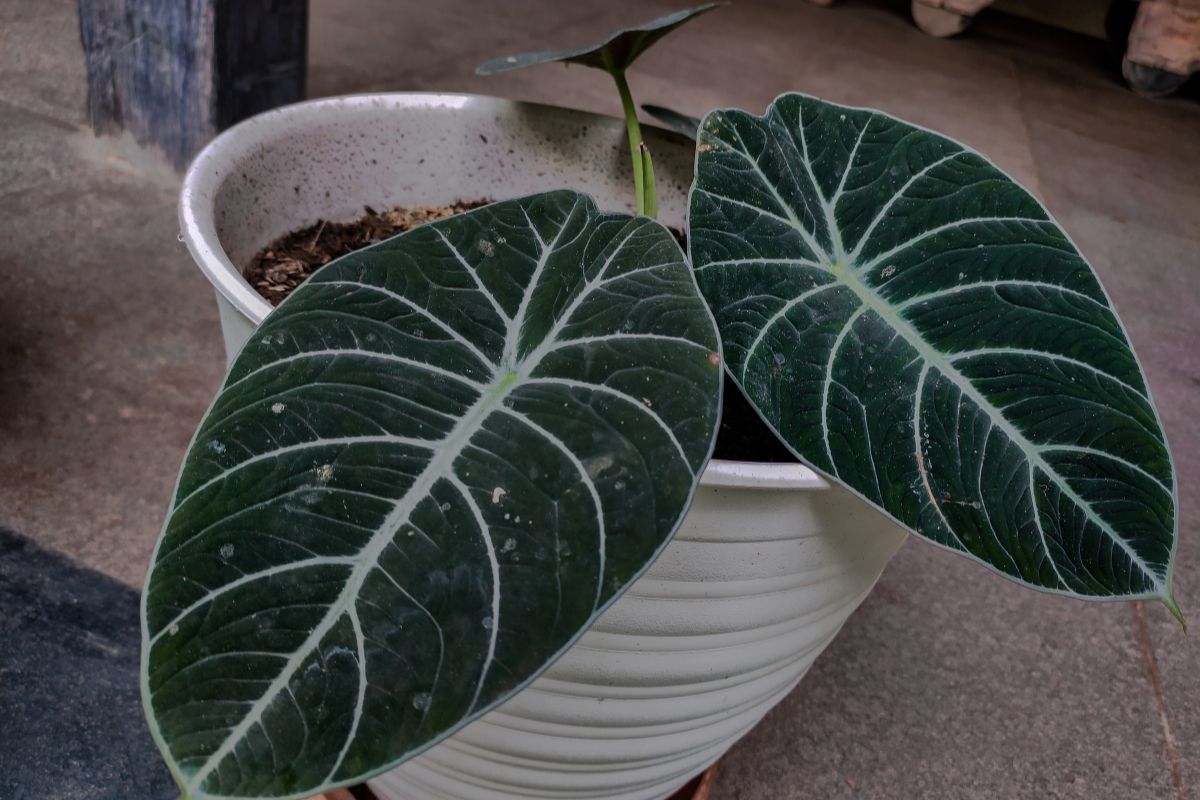
Dragon Scales From Alocasia
This Alocasia leaf is what draws most people in. It’s a lovely, evergreen plant. This plant has large, silver-green leaves that are round in shape. A darker vein that reflects a dragon scale is at the top. The veins and underside of the leaves are very attractive.
Every plant enthusiast wants this in their collection because it requires little upkeep. Additionally, it looks attractive. It is the Alocasia family’s most beautiful rhizomatous plant.
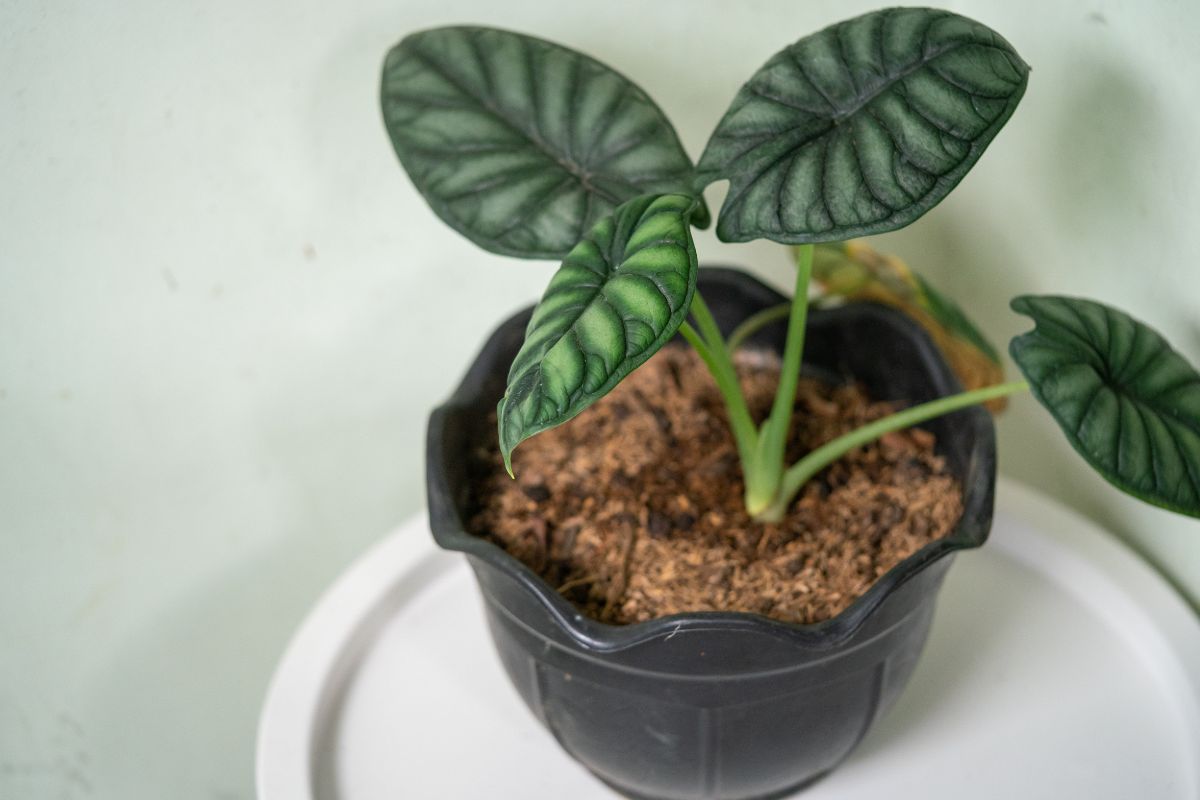
Dwarf Alocasia Cucullata With a Hood
The most attractive plant is Alocasia cucullata. Its foliage is a stunning heartleaf green. It also has a substantial green stem. On the surface, the leaves appear to be a clump. Its flowers are very uncommon. However, its stem and leaves are amazing.
You must know this lovely plant’s reputation as a lucky charm. People store it at temples in Laos and Thailand. Therefore, it will make a wonderful garden adornment. It can provide you with those advantages as well. Its upkeep is likewise relatively easy.
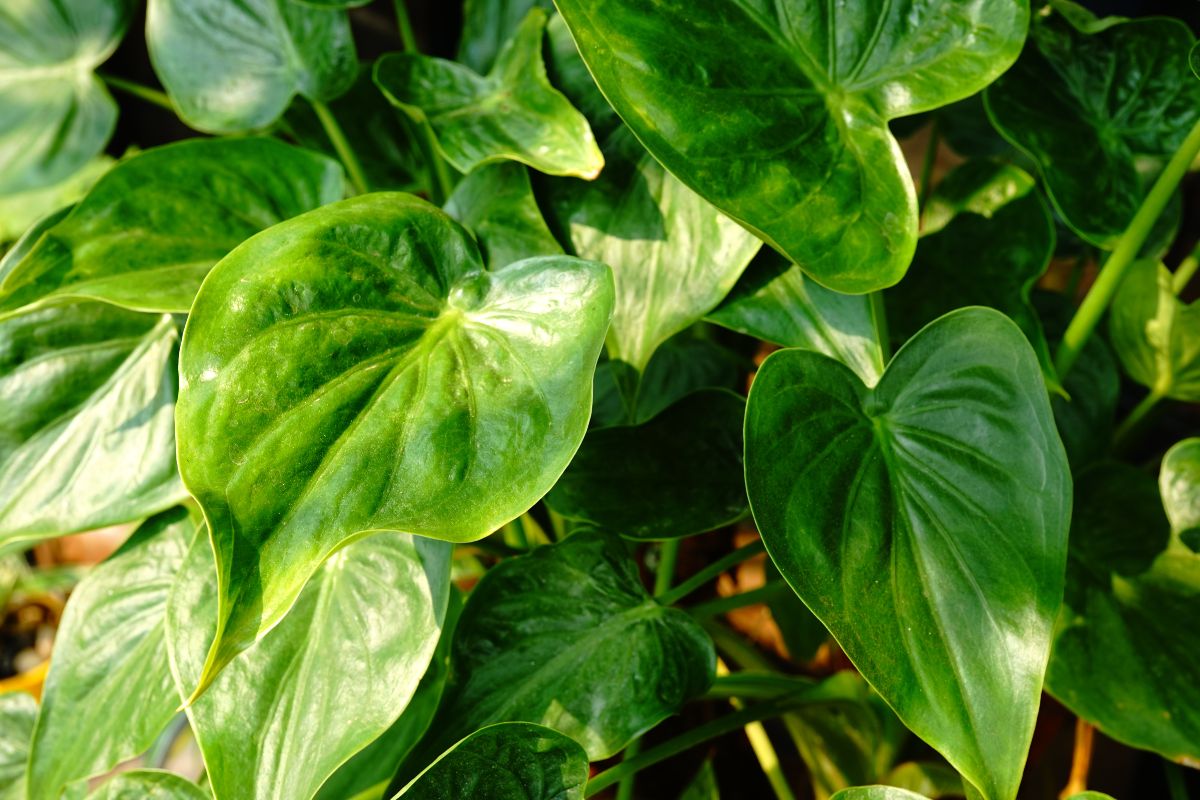
Frydek, Alocasia Micholitziana
This is one of the most beautiful plants from the Alocasia family. It was a few years ago when this unusual plant first gained popularity. Rarely does it give blooms. The stems are a little small. Its leaves are green with white veins, making it the most distinctive and gorgeous plant as a result.
It is also a low-maintenance plant with this kind of specialty. It is simple to handle, and anyone can manage it. Therefore, having this will make your yard elegant.

Giant Taro Alocasia Macrorrhizos
Another name for the enormous Alocasia macrorrhizos is Giant Taro. This lovely plant will add decoration to your garden. It is a plant that grows quite quickly. It has gorgeous rosette leaves and green color. You can cultivate it both inside and outside.

Heterophylla Alocasia
The leaves of this tiny herb plant have a striking blue metallic luster. This plant may support three or four leaves at once. Therefore, growing 3 to 5 plants in a pot is best. The surfaces of the leaves are smooth and glossy. The leaves are various shades of green and blue-grey. They have arrow- or heart-shaped ears. The plant has few lateral veins.
Given a medium-growing environment, it requires little upkeep. Additionally, it looks attractive. Anyone can manage it with ease. Many species are highly poisonous to both people and animals. It is a beautiful rhizomatous plant. It may serve as the focal point of a garden or room.
Infernal Alocasia
Due to the leaves’ natural black gloss, this plant is incredibly attractive. Oval-shaped and dark, dark-green leaves cover this magnificent aloe plant. These leaves have large veins. Due to its modest size, this plant can quickly grow in a terrarium.
Longiloba Alocasia
This Alocasia is a decorative plant with a glamorous leaf. The leaf has an arrow form and a bluish-green color. You can see silver in the periphery. It can sometimes astound you with its blossoms. Its leaves might draw people in.
It is a plant that proliferates with proper care. Be mindful of the temperature. It cannot breathe below 50 degrees Fahrenheit (10 degrees Celsius). There are more factors that you have to take into account. This plant will always adorn your garden.
‘Nigra’ Alocasia Plumbea
This particular Alocasia has broad leaves. The underside of the leaves is metallic black and has a surface hue of dark green. The leaves’ edges have waves. The leaves appear to change from dark green to dark purple due to their glossy shine. The vein is darker. In the warm, late-summer breezes, these magnificent plants sway pleasantly.
The leaves of this low-maintenance shrub are big. Direct sunlight will damage it. Additionally, it looks attractive.
Odora Alocasia
This Alocasia leaf is what draws most people in. It requires little work and has enormous, luscious foliage that makes your environment good. This plant has a pleasant scent. Like taro and Colocasia giganta, this plant has elephant-ear-shaped leaves. The upward-facing leaves are a deep green color.
Every plant enthusiast wants this in their collection because it requires little upkeep. Additionally, it looks attractive. It belongs to the Araceae family and is the most beautiful rhizomatous evergreen plant.
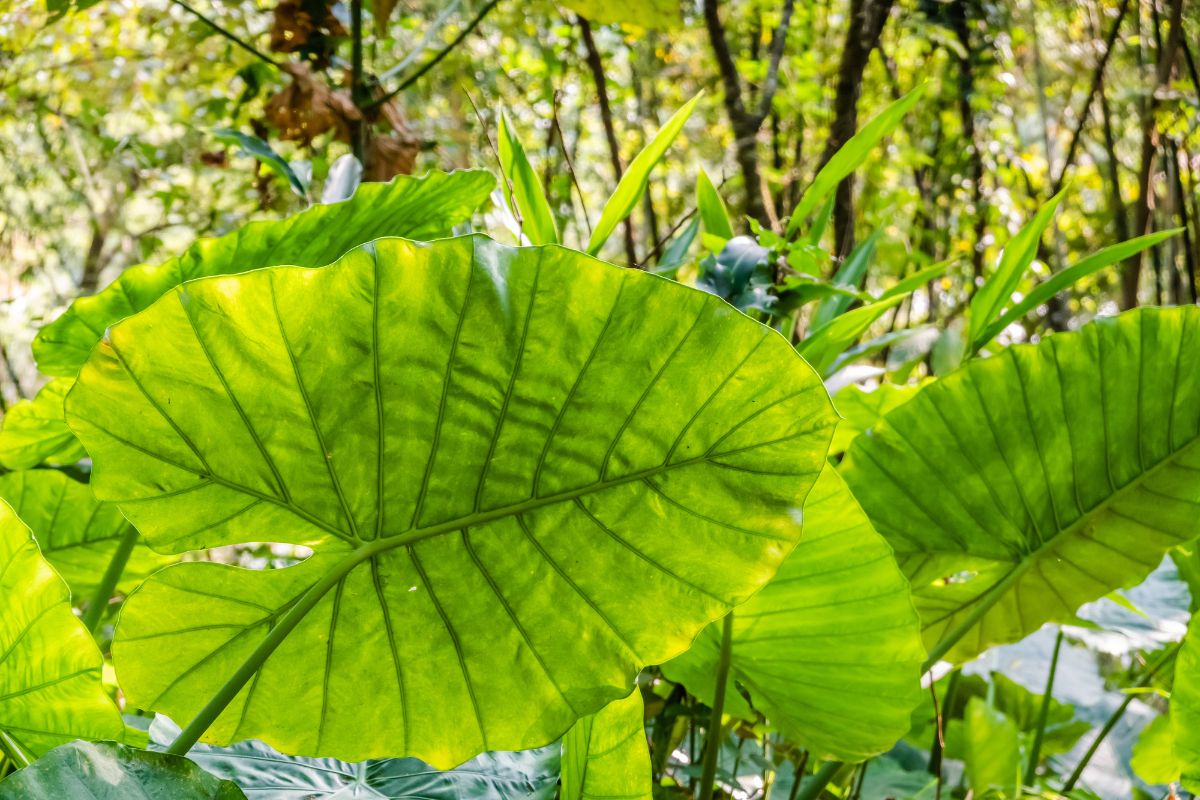
Reginae Alocasia
This plant grows more slowly, produces more leaves, and has several crowns. The underside of this plant’s leaves is rich crimson, while the upper surface is a darker green or bluish-green color. Darker green dominates the significant veins. Compared to other Alocasia varieties, this plant has leaves that are thicker in texture.
This is a tiny plant that grows quickly. One plant might thrive in a pot as it grows to fill the container. Its leaves give it a charming appearance. It is one of the newest attractive plants.
Secret of Alocasia Cuprea
If you want a beautiful plant for your indoor garden, pick Alocasia Cuprea. The leaf’s surface has a red-like tint with a metallic sheen. The border is almost entirely black with a striking red outline.
Your room will be elegant with its stunning appearance. It is a perennial plant. But its leaf is what draws people in. It multiplies as a plant. Additionally, the collection will be uncommon.
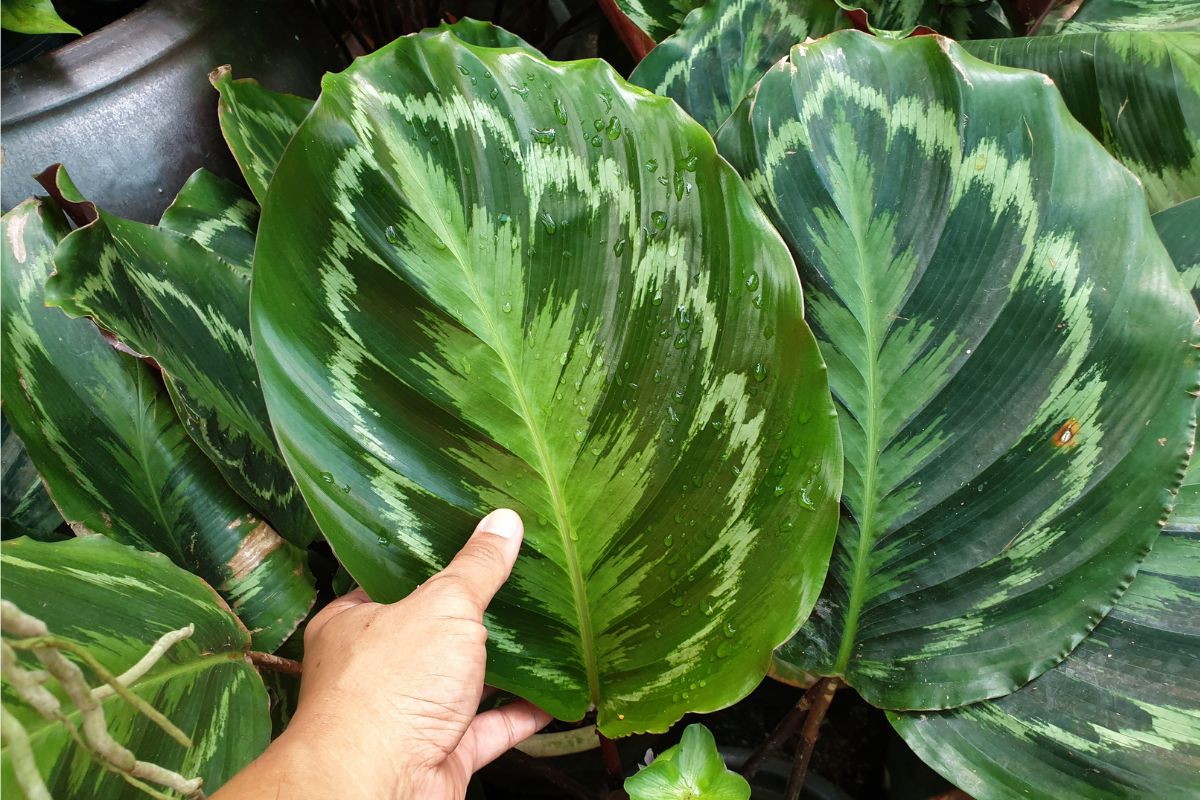
‘Stingray’ Alocasia Macrorrhiza
One of the most beautiful plants is Alocasia Macrorrhiza. The evergreen stingray can bring something special to your indoor plant collection. Its shape is lovely, and the leaves are enormous. It proliferates as a plant. Additionally, it requires little upkeep. It cleans the air.
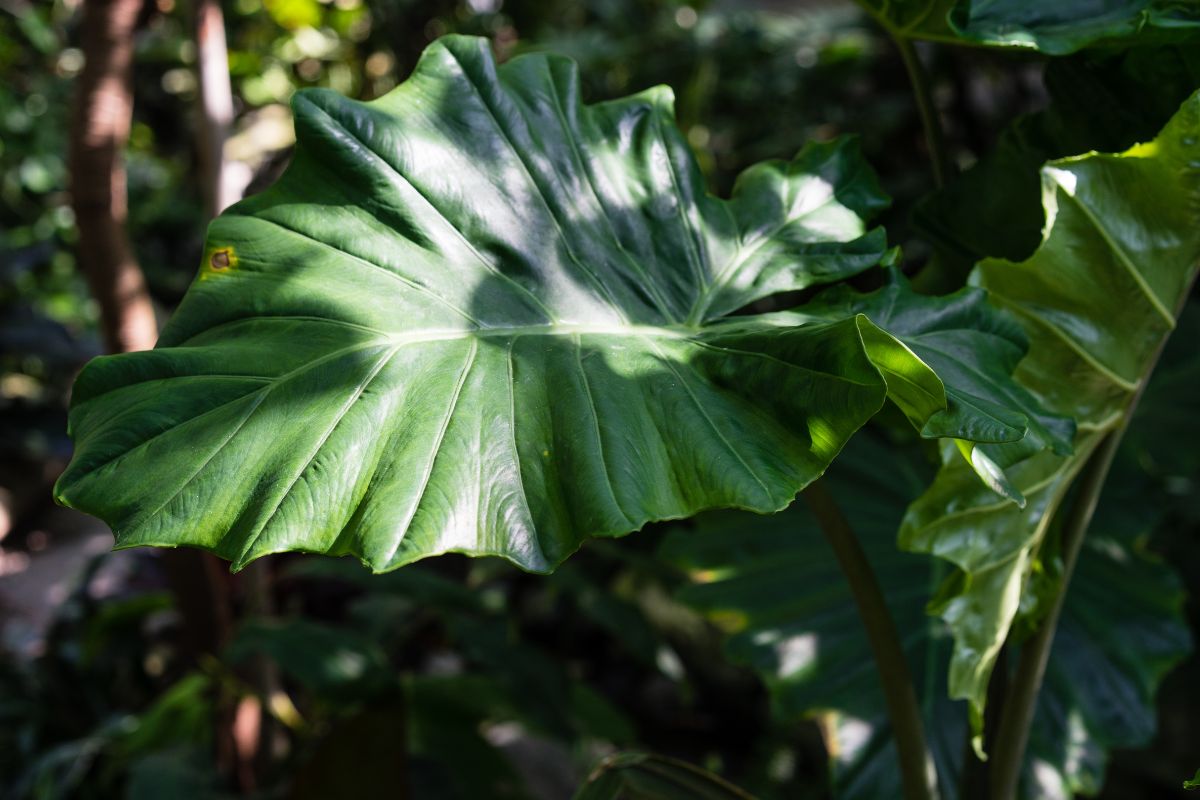
Sanderiana Alocasia
This plant is a great herbaceous perennial in the Araceae family. Because the wavy blade of a Kalis dagger and the wavy margins of this plant’s leaves are similar, this plant is also known as the Kris plant.
These plants’ leaves have arrowhead shapes and are strongly lobed. The bottom of the leaves is a vibrant green color with lovely white veins, while the upper surface of the leaves is a dark green color.
Every plant enthusiast wants this in their collection because it requires little upkeep. Additionally, it is very attractive. They are primarily grown as decorative plants because of their striking foliage.

Scalpia Alocasia
This kind of herbaceous, tuberous Alocasia is a real gem. Its foliage is lengthy and textured. The leaves resemble a sharp blade form. They have a blue tinge to their dark green color. The color of new leaves is much paler and lusher. The mature leaves have a thick, rubbery texture. Petioles on leaves are shorter than blades.
Every plant enthusiast wants this in their collection because it requires little upkeep.
The Sarawakian Alocasia
This plant has a uniquely unusual and bold appearance. It produces leaves that resemble glossy patent leather. The underside of the leaves is chocolate brown, while their surface is a peaceful, cool grayish-green.
This plant is incredibly decorative and a must-have for all plant enthusiasts. It is simple to grow and requires little maintenance.
It grows quickly as a plant. If planted in the ground, it tends to grow bigger. In the summer months, they give a striking element to the garden.
Indoor Alocasia Care
Since most Alocasias are closely related, they have comparable requirements and care guidelines. Reviewing the care instructions is always a good idea to ensure that your new plant flourishes. Here are some pointers for successfully cultivating Alocasia indoors.
Light
Alocasia plants prefer bright, dappled light. Try to recreate this environment at home, as they are typically found in the tropics under a canopy of trees, and keep them out of the hot, direct sun. The best window for them to face is an east-facing one. You can also place them next to (but not directly in front of) a south-facing window.
Temperature
Alocasias thrive in warm homes, at least 70 degrees Fahrenheit (21.1 degrees Celsius), because they are heat-loving plants. To prevent some Alocasia plants from going dormant and losing all their leaves, try not to let the temperature drop below 60 degrees Fahrenheit (15.5 degrees Celsius). Keep them away from single-paned windows and draft doors.
Humidity
Alocasias require a lot of humidity, at least 50%, to thrive. They struggle in dry settings and can dry out the air if you place them too close to a heat source (such as a vent or fireplace).
Keep your plant in the bathroom or kitchen, typically the most humid places in the house, to boost humidity, or gather multiple plants together to create your jungle haven.
Watering
It should be no surprise that Alocasias want wetness, but how much and how frequently they require water will vary depending on the sunlight and humidity in their surroundings.
Water your Alocasia plant once or twice each week during the summer. Water plants when the top 1 to 2 inches (2.54 to 5.08 centimeters) of soil feel dry during the winter when development slows down. Keep the soil completely dry during the cooler months, even though this may occur every 7 to 10 days.
Clean your plant a few times a year to remove dust, grime, dander, or other debris from the leaves.
Soil
Make sure you plant your plants in loose, well-draining soil, as Alocasias dislike standing water. Use sphagnum moss, bark, and perlite in equal parts to create a decent, primary potting media, which is the ideal soil for your Alocasia. You require the following ingredients to create the ideal aroid soil:
- Orchid Moss
- Orchid Bark
- Organic perlite for perfect plants
You may also purchase specialized aroid soil, which is perfect for Monsteras, Rhaphidophoras, Philodendrons, orchids, and Alocasias.
Fertilizer
Fortunately, Alocasias require little fertilizer. They only need a little plant food, even during peak growth. You can apply a monthly liquid houseplant fertilizer in the spring, summer, and fall. Since the plants aren’t actively developing in the winter, there is no need to fertilize. Recommended Alocasia fertilizers include:
- Maxsea seaweed plant food, all-purpose
- Liquid plant food from the houseplant resource center
- Instant plant food from instant biologics (fizzing nutrient tablets)
Alocasia FAQs
How Many Types of Alocasias are There?
The Alocasia genus has 97 known forms. Many new Alocasia plant hybrids are available worldwide, including the wildly popular Alocasia x Amazonica and Alocasia‘ Polly,’ which are not popular species because you can not find them anywhere in their native habitat, or the Amazon, for that matter.
What is the Easiest Alocasia to Grow?
There’s a good reason why Alocasia amazonica‘ Polly’ is a favorite. It’s not only the easiest to find Alocasia at garden centers and plant stores, but it also grows quickly. You can propagate it by dividing the roots and planting the parts again in potting soil.
How Can You Tell the Difference Between Alocasia and Colocasia?
Alocasia and Colocasia are members of the Araceae family, sometimes referred to as the tropical aroid family, and as such, they have a lot in common. Pay attention to their leaves, which demonstrate the most visible difference, to determine each genus apart.
The plant is most certainly a Colocasia if the leaf tips point downward. The plant is most likely an Alocasia if the leaves are upward-pointing.
Of course, there are exceptions, particularly in hybrids like the downturned-leaved Alocasia Amazonica‘ Polly,’ which is not a widespread species.
What’s the Difference Between Alocasia and Anthurium?
Native tropical plants Alocasia and Anthurium share similar botanical traits because they are both members of the Araceae family. However, if you’re having trouble telling these two plants apart, look closely at their leaves and petioles.
In contrast to Anthurium leaves, which are typically heart-shaped and droopy, Alocasia leaves typically have an arrow shape and a more upright form. While the petioles on Anthuriums grow from the stem, the petioles on Alocasias grow directly from the tuber. Of course, some outliers exist because some aroids are hybrid, but this should help you identify your plant.
Is Alocasia Toxic to Cats and Dogs?
When they consume the leaves of Alocasia plants, calcium oxalate crystals induce a burning feeling in the mouth. Keep curious pets away from these houseplants.
What is the Ideal Care Guide for Alocasia Outside?
The following is a comprehensive guide on caring for common Alocasia plant genus and understanding how they grow:
Tropical woodlands are the natural habitat of aloe plants, which flourish on the jungle floor. Alocasia species are not affected by harsh winters or arid, dry environments. The majority of Alocasia plants are large annual tropical species with enormous leaves.
Alocasia, with its magnificently large arrowhead leaves and glossy greens, is a decent illustration of tropical plants. Popular aloe vera cultivars like aloe Amazonica Polly and aloe Zebrina thrive in warm, indirect sunlight and moist soil, making them good interior plants.
Alocasia plants thrive in indirect sunlight and a flexible potting mix with good drainage. The Alocasia plants need frequent waterings to maintain their slightly damp plant roots, and they benefit from regular mistings to increase humidity for healthy growth. The temperature range for aloe vera plants is between 59 and 82.4 degrees Fahrenheit (15 and 28 degrees Celsius).
Since Alocasia originated in tropical forests, its growth requirements are similar to those of houseplants. They grow most agreeably in a bright space without direct sunlight. An abundance of light ensures bright color and supports healthy development.
In a room with southern exposure, place the plant almost 1.5 meters (4.92 feet) from the window or cover it with a sheer curtain. In dimly lit spaces, some houseplants don’t grow as well as they should. Inadequate lighting causes a slower rate of development and fading leaves till they drop off.
Alocasia plants should only be grown in spongy soil with excellent drainage. Mud, peat moss, and perlite combined in equal parts make a great ‘Alocasia soil’ mixture. These potting materials give the plant excellent drainage and carry a pleasantly wet atmosphere. For Alocasia plants, getting suitable soil composition is essential for upkeep.
Watering Method
Alocasia plants require regular moistening to keep the soil evenly moist. The best way to determine whether your broad-leafed Alocasia needs water is to check the top 0.39 to 0.98 inches (1 to 2.5 centimeters) of soil for dryness. Provide enough water to keep the soil continually evenly moist.
Watering sparingly but frequently is the best approach to keep the ground’s moisture levels constant because aloe plants can die if the mud is too saturated. Alocasia plants enter a period of hibernation during which essentially all of their growth stops, and some foliage may separate.
As a result, it is necessary only to irrigate Alocasia plants in the winter, when the top 5 cm of muck is devoid of water.
Range of temperatures
Warm environments are great for aloe vera plants. Thus their recommended temperature range for healthy growth is 64.4 to 80.6 degrees Fahrenheit (18 to 27 degrees Celsius). Wherever you raise tropical plants, it’s essential to respect their native habitat temperatures; therefore, don’t drop them below 59 degrees Fahrenheit (15 degrees Celsius) during winter.
However, it’s imperative to keep the potted plants away from the sun’s direct rays and chilly breezes.
Conditions for Humidity
Aloe vera plants need 50 to 60% humidity to thrive indoors. For these moisture-loving plants, household air is typically too dry, so to ensure their longevity inside your home, you should water the Alocasia leaves daily. Also, you can use a room humidifier or place the pot on a rock tray half-filled with water to improve humidity conditions.
Plant Feeding Role
Alocasia houseplant varieties benefit from additional fertilization applied every two weeks during their growing phase from spring to summer. To help your aloe plant thrive, use organic, natural fertilizers. Leave it in a pot overnight to water out while the chemicals evaporate, bringing the water up to room temperature.
Repotting Method
Alocasia plants don’t require frequent repotting. These plants thrive in containers when their roots are tightly tied. You can disturb an Alocasia plant and temporarily force it into droopy growth by the occasional repotting. Use a larger pot than it is in for an Alocasia plant and apply the right mud combination to finish this operation perfectly.
Remember to check the roots for signs of deterioration. Repotting is the best method for growing new Alocasia plants when you already have a large one.
Multiplying Method
You can grow large Alocasia plants by breaking the branches or dividing the roots. Sometimes, you’ll see little “baby” plants growing near the parent plant. You can clip and grow in a fresh jar. Maintaining Alocasia plants in warm, humid conditions is crucial while propagating them.
Pruning Alocasias
Alocasia green plants hardly ever require pruning. Fresh leaves grow on the plant, while the older ones become brown and die. However, you can remove damaged or yellowing leaves to improve the plant’s appearance.
Avoid watering if you notice overwatering signs until there are 0.98 to 1.96 inches (2.5 to 5 centimeters ) of muck. You can repot your Alocasia in a different combination if it’s still having trouble reviving. Before planting again, remove any dead vegetation.
Other Plants That Look Like Alocasia
Colocasia
Colocasia is a widespread species that can reach 3 feet (0.91 meters), and you can find it in muddy areas of Asia. Colocasia is a well-known plant for garden decorating and is relatively natural in those parts of Asia where the climate is humid.
Furthermore, some members of this species can reach heights of up to 8 feet (2.43 meters); thus, 3 feet (0.91 meters) long is not their maximum size. This plant’s structure is primarily what draws people to it. The heart-shaped design has a size that reminds one of elephant ears. Additionally, this plant’s tip always grows downward, exposing the upper leaf portions.
They require appropriate moisture and heat to develop because they are widespread in Asia’s swampy regions. Therefore, if you intend to cultivate them in your garden, you must keep them in a location where they receive adequate sunshine.
Planta Alocasia
In the genus Alocasia, you can find leaves that resemble elephant ears. There are 70 species in this genus with gigantic leaves that resemble enormous elephant ears. The plant from the giant taro, also known as Alocasia macrorrhizos, is one of the most well-known members of the Alocasia genus.
This species is also famous for its long leaves, reaching 12 to 15 feet (3.65 to 4.57 meters)
The breadth of the leaves is the feature of the Alocasia macrorrhizos that many find most intriguing. This species’ leaf blades can enlarge to a width of 2 to 5 feet ( 0.6 to 1.52 meters). For this reason, people like to grow them in their gardens and compare their leaves to elephant ears.
Alocasia Plumbea, also known as metallic taro, is another well-known species in the Alocasia genus. Although they are smaller than Alocasia macrorrhizos, their dark glossy bronze hue gives them the appearance of having elephant ears. All Alocasia species are suitable for growing in tropical climates and prefer a warm atmosphere.
Xanthosoma
Xanthosoma, which resembles Alocasia, grows in the New World Tropics, which encompasses the regions of North and South America. Since Alocasia and Colocasia are uncommon in tropical Asia, this species is entirely distinct from them.
Because the tip of its leaves is sharp like arrows, this species’ distinctive structure gives them the nickname “arrowheads.” This characteristic makes them distinguish themselves from other Asian plants resembling elephant ears.
The two species of Xanthosoma with the largest elephant ear-shaped leaves are Xanthosoma maffafa and Xanthosoma sagittifolium. They often reach 2 to 5 feet ( 0.6 to 1.52 meters), but occasionally, particularly in the case of Xanthosoma sagittifolium, they can reach up to 9 feet ( 2.74 meters).
Diamond Head
This Colocasia species, known as “diamond head,” resemble elephant ears. Because of its shiny qualities, this species is particularly popular with humans. A diamond head is the greatest elephant ear type plant for those who enjoy gardening since they always look for something distinctive to add to their gardens to make them stand out.
When fully grown, diamond head leaves can reach 3 to 4 feet (0.91 to 1.21 meters) in height and breadth 2 feet (0.60 meters). Although their large leaf structure gives them the appearance of elephant ears, the glossiness of the leaves is what draws people in.
To further explain, the surface of this species with enormous leaves is a distinctive blue-black color with a hint of glossiness. As a result, when you expose this species’ leaves to sunshine, they reflect the light and create a magnificent perspective of your landscape.
The diamond head needs plenty of sunlight to grow well in your garden; otherwise, it won’t produce the greatest results. In addition, this plant needs adequate water because it cannot grow without it.
Pink Symphony
Another elephant ear-structured plant with a distinctive appearance is the pink symphony. Its creamy pink color gives it this appearance. Although they are smaller than other species with structures resembling elephant ears, these plants have an elephant-ear appearance.
This pink symphony is the greatest option if you have a tiny garden yet want to produce plants with an ear-like elephant shape. Because this particular indoor elephant ear plant’s leaves and stems are relatively smaller, they don’t require much space. As a result, you can grow them in containers since they are 14 inches (35.5 centimeters) long.
Furthermore, these plants prefer shades and do not require direct sunshine to develop. They prefer dry soil and dislike spending a lot of time in wet soil because they need soil that absorbs water quickly.
Facts About Alocasia Plants
- The Araceae subfamily of the genus Alocasia. Aroids are the popular name for members of this family. There are roughly 80 species, most indigenous to southern Asian tropical and subtropical climates. Additional types are in the market as a result of hybridization initiatives.
- Alocasia is a perennial rhizomatous or tuberous plant with broad leaves. The plant has the jack-in-the-pulpit inflorescence that typically grows at the end of a stalk, concealed by the leaf petioles, just like a conventional aroid.
- The araceous bloom in question is nondescript and shortly dries up. Elephant’s Ear is a common name for the plant that derives from its magnificent foliage.
- These broad, heart- or arrowhead-shaped leaves frequently exhibit eye-catching patterns and colors.
- Most cultivars are green or black, while some have stunning white ribs and leaf variegation.
- Huge species can grow to heights and widths over 9.84 feet (3 meters). As a result, Alocasia plants have many uses in a garden.
- The small Alocasia varieties are mass-planted as edging, ground cover, or borders for a dramatic tropical effect, whereas the large-leaf types are not frequently popular.
Is Alocasia Resilient?
In Zones 7 and higher, plants are hardy and can withstand low temperatures. Alocasia thrives in containers that stay indoors during the winter farther north than Zone 7.
Plant this tropical gem in good, well-drained soil in full sun to partial shade. Do the plant division every year or two. The leaves get little if the plant grows in clusters.
The leaves grow to their largest size when you plant them alone, creating a striking statement in the landscape. In addition to well-drained soil that is regularly moist, plants can also survive in shallow water.
Remove “pups” that develop at the base of parent plants if you want to grow more Alocasias. Could you give them to family and friends or replant them in different garden locations?
After the spathe dies and the bright red berries that carry the seeds reach maturity, harvest the seeds. The seeds will easily germinate if you plant shallowly in moist, sandy soil.
Common Varieties
The Alocasia is famous for being quite intricate in all shapes and sizes. It might be challenging to distinguish between the various hybrids and cultivars in the market. However, they are highly-prized much for their lovely foliage.
The giant taro or upright elephant’s Ear, Alocasia marorrhizos, one of the largest kinds, is a native of the tropical Asian jungle. Both the petioles and the rhizomes are edible. Every time a new leaf emerges, the stem gets larger.
Planta Alocasia
Alocasia marorrhizos selections come in a variety of shapes, including A. Marorrhizos Variegata, which has leaves in shades of green, cream, and white; Metallica, which has a dark magenta-green petiole; Seven Colours, which has obvious yellow blotches on the leaves; and Lutea, which has yellow stems and veins.
One of the most widely planted varieties is the hybrid (not a species) Alocasia x mortfontanensis Andre, often known as African Mask or Amazon Elephant’s Ear (synonyms: Alocasia longiloba x Alocasia sanderiana hybrid and Alocasia x amazonica).
It has an arresting form. Its lustrous, dark-green leaves have contrasting white veins and borders. The plant can heighten to about one meter. Reginula Alocasia Southeast Asia is the home of Black Velvet, often known as the “little queen of Alocasia.”
This unique dwarf species of Elephant’s Ears, which rarely grows higher than 11.81 inches (30 centimeters), has a heart-shaped, velvety, green-black leaf with silvery-white embossed veins. It’s astonishing how thick and rigid the leaves are if you touch and feel them.
Alocasia Hilo Beauty, Alocasia Hana, Alocasia cuprea, and Alocasia rugosa are other types with a size comparable to A. reginula. Each makes an impression thanks to its distinctively captivating and endearing appearance.
Growing Alocasia
- Although they prefer lots of light, aloe vera plants cannot withstand intense direct sunshine. So, plant them in light areas like the porch edge or beneath trees that provide shade.
- Larger Alocasias, such as the species and variations of A. marorrhizos, need more light and can withstand direct sunshine; they thrive in full sun to partial shade environments.
- Use any loose, porous soil mixture. To keep the soil constantly moist, water plants every day.
- To encourage a healthy and robust growing plant, feed the plant with any balanced fertilizer and remove drooping leaves or inflorescence. To multiply, split the rhizome.
- When selecting a plant from a nursery, look at the setting location. Grow the plant in similar habitat at home.
- Be cautious not to eat Alocasia species because they can be harmful.
- Usually, the plant will begin to slow down after flowering. After some time, new growth will start to show.
- Elephant ears are another name for Xanthosoma, Colocasia, and Caladium plants.
That’s All, Folks
The popular tropical plant genus Alocasia thrives in indoor environments. The majority of kinds are the perfect size for container gardening, and you may choose from a wide variety of unusual colors, forms, and growth patterns to suit your fancy.
Alocasia species can have numerous variants, each with its distinctive characteristics. For instance, the species Alocasia baginda includes the variations Dragon Scale, Silver Dragon, and Green Dragon. You can always have a few Alocasia plants if growing your houseplant collection is your special hobby.
It is comparatively simple to grow this tropical plant. You’re ready for the challenge if you’ve worked with distant relatives like Pothos, Peace Lilies, or Philodendrons. Additionally, you can have numerous Alocasia plants in your collection without much visual or stylistic overlap, thanks to the wide range of uncommon types available.
The Alocasia varieties are a must-have if you love plants and want to freshen up your house, garden, or patio. These plants are famous for their gigantic size, distinctive foliage colors, striking markings, and magnificent leaves. We hope this advice helps you choose an Alocasia since there are many different kinds.
